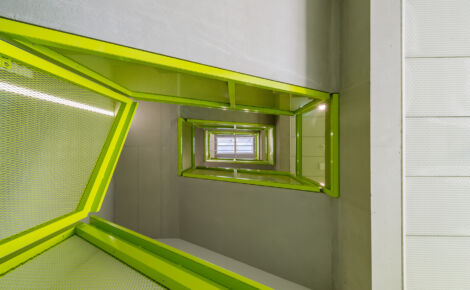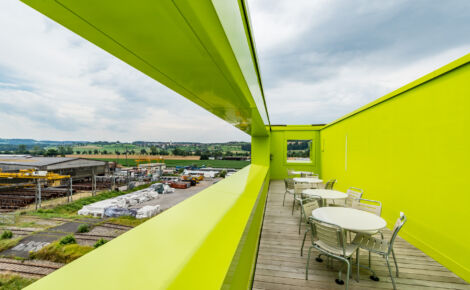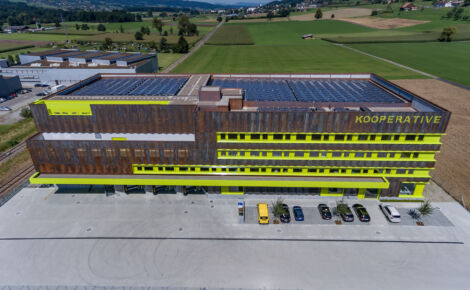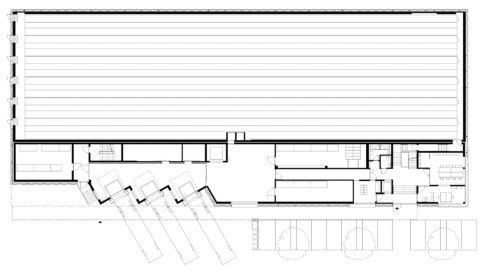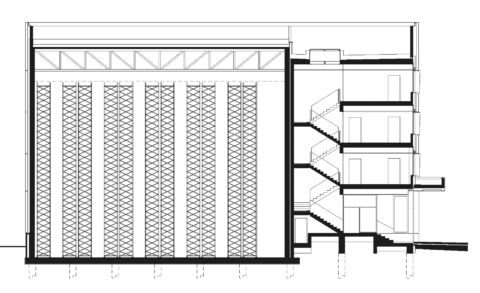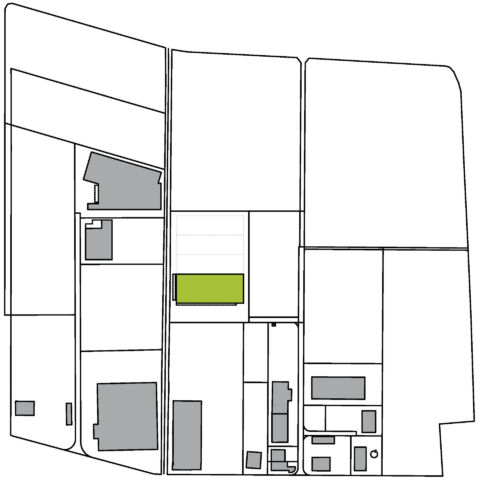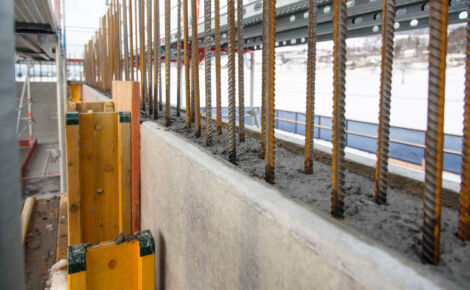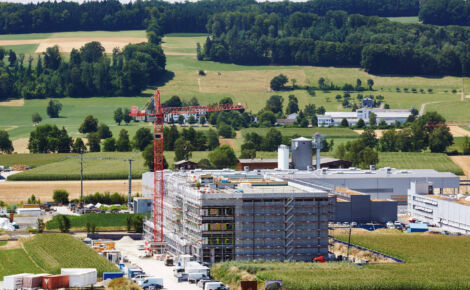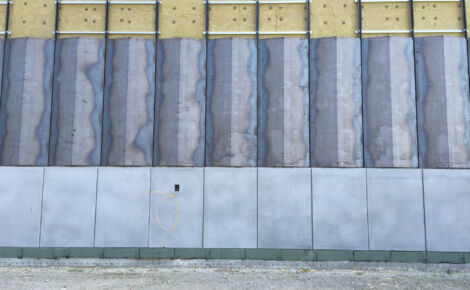months’ construction time
Building
The Cooperative Storage Library Switzerland building is an industry-type construction with state-of-the-art building services engineering and a large, inert-atmosphere high-bay container storage system. It is designed to meet the Swiss “Minergie P” standard. High sustainability is achieved with geothermal heat exchangers, a photovoltaic installation and waste heat recovery.
Facts and Figures
construction costs. Despite additions, actual construction costs were lower than the original budget.
concrete piles bear the weight of the books.
Architecture
The building is separated into two use areas – the high-bay storage facility and the administrative wing. The dimensions of the high-bay storage facility are based on internal use. The administrative wing is seamlessly connected to the storage facility as a narrow tier which is subdivided into two areas. Actual operations are stacked vertically one on top of the other and located on the eastern side of the building (the side on which visitors arrive). Delivery and technical service areas are located on the western side.
Vertical circulation around the building takes place via the open stairs in the main entrance area. There is also an internal emergency stairway which accesses the roof and provides access to the technical areas. The goods lift is located in the centre of the building. On the ground floor it is adjacent to the delivery area and on the upper floors it is in direct proximity to the picking stations.
The entire building has been constructed using solid construction methods. This provides numerous advantages in the high-bay storage facility, which must meet predefined internal climate requirements. Thanks to the concrete walls and steel floor joists it has been possible to create a large, support-free internal spaces. The structure is cantilevered and therefore earthquake-proof.
- Concept
Planning requirements specified an automated storage facility and an administrative wing; the desire was to unite both uses in one building. Requirements also included the option to expand the high-bay storage facility in a modular manner without interrupting ongoing operations. Additionally wishes were an energy-efficient building; a low-maintenance façade and an extendable, sustainable construction design. The positioning of the administrative wing, which also includes technical services, now anchors the building to its surroundings, with the storage facility appended to it. The administrative wing’s elongated position has the advantage of a wide façade which provides large amounts of natural light for the workspaces. The use of modular concrete elements facilitated efficient construction of the storage facility. These double-skin, thin-wall concrete elements are lightweight, can be prefabricated off site and quickly installed. They were filled with liquid concrete on site and, in combination with reinforcements which had already been installed into the elements, resemble monolithic 36-cm thick steel reinforced concrete walls. Steel trussed girders span the approximately 75 m long and 20 m wide structure without supports.
Should the building be extended, then its rear curtain-wall façade can be removed; an additional module constructed and the façade then reinstalled. The concrete elements making up the old rear wall remain in place as they have pre-marked openings to allow expansion of the horizontal conveyor belt system. The entire building is hermetically sealed and has an inert atmosphere. The reduced oxygen content in the atmosphere prevents the starting and spreading of fires.
- Building mass
Building mass 76.2 × 32.8 × 19.4 m Plot size 11'606 m² Building floor area as per SIA 416 2'415 m² Sealed surrounding surfaces 2'923 m² Floor area as per SIA 416 6'702 m² Net floor area 4'360 m² Building volume 41'519 m³ Façade area 4'114 m² Floors 4 Loading docks 3 - Building protection
- The building is earthquake-proofed.
- It is secured by alarm systems for fire and burglary and has a CCTV system.
- The perimeter of the premises is secured with a 2 m-high wire-mesh fence and access is controlled with a sliding gate.
- Construction project organisation
Client Speicherbibliothek AG Client representative Dienststelle Immobilien
Kanton LuzernGeneral planner/architect/construction management gzp Architekten, Luzern Construction engineer Basler & Hofmann Innerschweiz AG, Luzern HVACS planners Amstein + Walthert AG, Zürich Sanitary facility planner Josef Ottiger + Partner AG, Luzern Electrical system planner Jules Häfliger AG, Luzern Construction physics Ragonesi Strobel & Partner, Luzern Logistics/operations planning RALOG Engineering AG, Zofingen Façade planning Eleconstruct AG, Emmenbrücke - Layout plans
1st floor layout for publication without details and room designations. Ground floor layout. Cross-section. Büron Chlifeld site plan without details.
Facade
The building is clad with folded Corten steel sheets. Surface corrosion on the sheets gives the building patina, helping it blend with the surrounding wooden, tiled-roof barns. The choice of folded sheets makes the structure appear smaller, while the interplay of light and shadow they create provides the building with an unmistakeable identity. Should an extension be added, then the cladding sheets can be removed and then reattached to the new façade. The contrasting lime green used for the window casements echoes the lush green environment.
- Façade construction and design
The building envelope is clad with a rear-ventilated metal curtain-wall façade constructed from weather-proof construction steel (Corten steel). A copper-, chrome- and, where applicable, nickel-based alloy forms a barrier layer which protects the steel from further corrosion. Just as with normal steel, exposure to the elements and corresponding damp, rain and dryness causes the Corten steel to rust. Thanks to the alloy elements a complex, adherent, non-permeable barrier layer is, however, formed between the base material (steel) and the existing layer of corrosion. This process takes around one to two years. During this period, the surface has patchy areas of rust, following which the layer of rust is evenly spread across the entire surface and the corrosion process stops. Although the sheets feel rough, rust particles adhere to them.
The architects placed value on the analogy of the descriptive terms ‘book storage = knowledge storage’ and ‘building extension = knowledge extension’. The industry-type construction should also reflect the building’s rural industrial character. The colour of the raw steel sheets should echo the colour pallet of the surrounding tiled roofs and farmland. The steel’s durability was another reason why it was chosen as was the fact that it simultaneously makes the aging process visible. The chamfered sheets are folded, which, on the one hand, makes the large structure appear smaller, while, on the other, this also allegorises plans for its extension by referencing an accordion. The strong refraction of light around the folds creates a richly contrasting interplay of light and shadow, giving the building, which can be seen even from a distance, an unmistakeable identity.
In addition to this, the folds in the steel also serve to stiffen them, benefitting the building’s statics and saving material. A perforated strip inserted into the upper sheets subtly draws attention to the edge of the roof as well as serving to ventilate the façade. The perforations are also repeated in the signage, which takes the form of green sheeting in this area. The plinth is comprised of fluted concrete elements which channel with rainwater away from the building, thus preventing rust in the water from causing uncontrolled discolouration.
Costs and funding
The financial means necessary for the construction of the building were provided by the Speicherbibliothek AG public limited company (plc). The plc owns the plot and existing real estate reserves. Despite additions to the project actual costs were lower than the original budget.
- Investment costs
BKP 0 Plot CHF 3'150'000.00 BKP 1 Planning work CHF 1'795'632.75 BKP 2 Building CHF 14'587'264.00 BKP 3 Operating equipment CHF 9'084'302.15 BKP4 Surrounding area CHF 876'400.50 BKP 5 Ancillary construction costs CHF 989'865.95 BKP 6 Fixtures and fittings CHF 263'645.45 Total investment costs CHF 30'747'110.80

